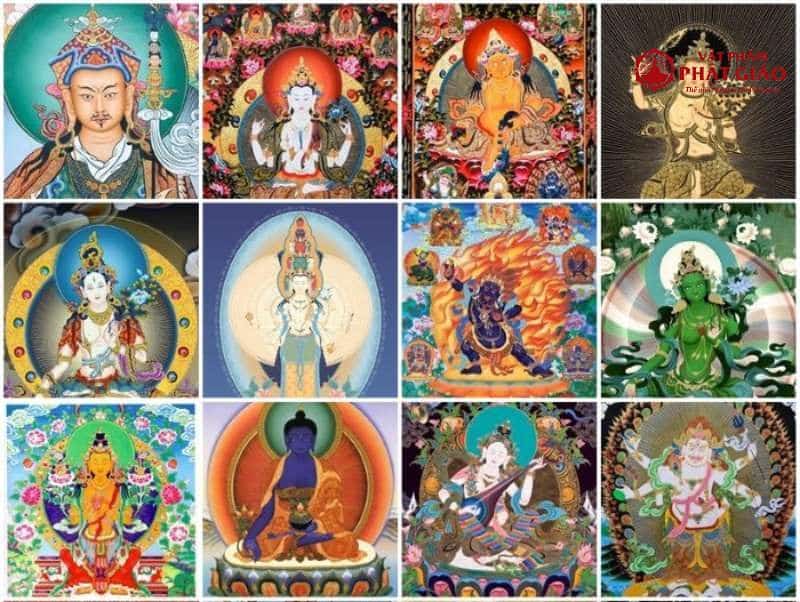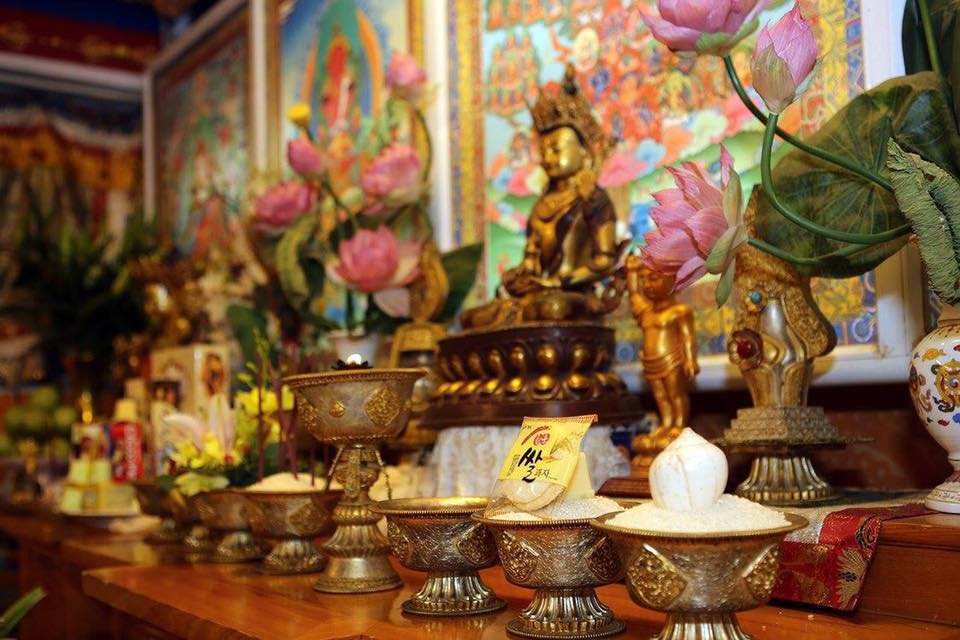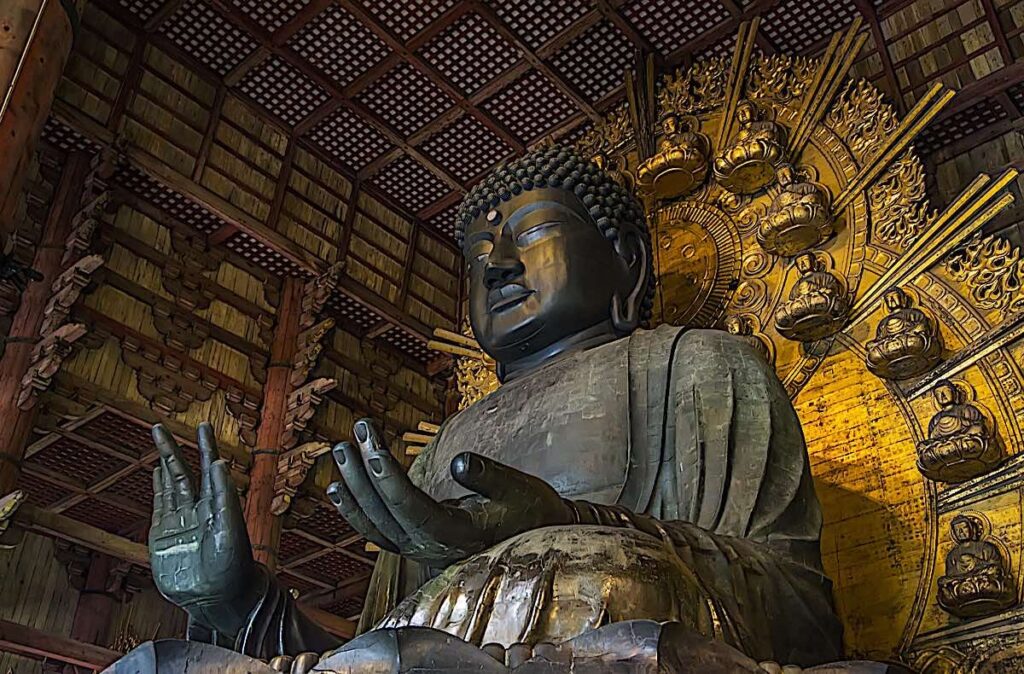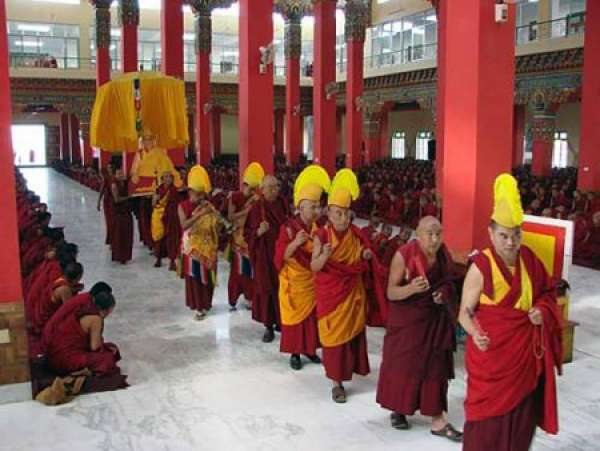Tantric Buddhism is a distinctive practice that originated from the integration of Hinduism and Mahayana Buddhism. It was formed around the 5th and 6th centuries in India. Tantric Buddhism is also known as Esoteric Buddhism, Mantrayana, Vajrayana, or Secret Mantra Vehicle…
Many friends of LotusBuddhas have said that if the path to enlightenment is compared to climbing a mountain, then Tantric Buddhism is like a cable car that helps practitioners reach the summit faster than any other path.
This comparison may seem humorous, but it is fitting when we talk about the esoteric practices of this Buddhist tradition, where secret practices can help practitioners break through on their spiritual path. However, simply put, it is not easy. In this article, LotusBuddhas will share useful knowledge about Tantric Buddhism to help you better understand this mysterious branch of Buddhism.
Although the unfolding of Tantra’s chronicles has occasionally strayed from the core Buddhist ethos, entangled with sorcery and dark arts, the wisdom of revered Tibetan masters has illuminated the true essence of this lineage. Vajrayana or Diamond Path, emerges as a quintessential aspect of Tantric Buddhism, bestowing practitioners with the means to attain heightened awareness, serenity within, and an intimate communion with the cosmos via intricate visualization practices, adept yogic methods, and a deep comprehension of interdependence.
What is Tantric Buddhism?
According to the Wikipedia encyclopedia, Tantric Buddhism is a term used to refer to a practice originating from the combination of Hinduism and Mahayana Buddhism, formed around the 5th and 6th centuries in India.
Tantric Buddhism is divided into two sects: Mantrayana and Vajrayana. The development of Tantric Buddhism is associated with famous scholars such as Subhakarasimha (637-735), Vajrabodhi (671-741), Amoghavajra (705-774), Padmasambhava (late 8th century), and Dipankarasrijnana (Atisa, late 11th century). Padmasambhava and Dipankarasrijnana played significant roles in introducing Tantric Buddhism to Tibet, where it became the main religion.
Tantric Buddhism is also known as Esoteric Buddhism, Mantrayana, Vajrayana, or Secret Mantra Vehicle. It is a secret practice within Buddhism, teaching about “mudras,” “mantras,” etc. This practice is considered comprehensive and profound, based on the secret transmission of the dharma essence.
Tantric Buddhism is said to be like a swift and powerful river, allowing those who practice it to traverse the path to enlightenment more rapidly than other forms of Buddhism. The essence of this practice is the union of wisdom and compassion, symbolized by the union of male and female deities in meditation.
Tantric Buddhism is a powerful and transformative spiritual path that leads us to the ultimate realization of our true nature.
In our day-to-day lives, we often find ourselves caught up in the ceaseless whirlwind of thoughts and emotions. Tantric Buddhism offers us tools to still this tempest within our minds, allowing us to cultivate a deep sense of inner peace and harmony. Through the practice of tantra, we learn to embrace every aspect of our experience, transforming our mundane, everyday lives into a sacred spiritual journey.
Meaning of the word “Tantra”
The word “Tantra” has its origins in Sanskrit, an ancient Indian language. It is derived from two root words: “tan” meaning to expand, stretch or extend, and “tra” meaning tool, instrument or technique. In a broader sense, Tantra refers to a body of esoteric spiritual practices, rituals, and beliefs that originated in India and later spread to other parts of Asia, including Tibet, China and Japan.
Tantra is often associated with cultivation and transformation of energy, particularly sexual energy, for spiritual growth, healing and attaining higher states of consciousness. It encompasses a diverse range of practices and teachings that aim to weave together different aspects of life, such as spirituality, sexuality and everyday activities, to attain spiritual awakening and liberation.
While Tantra has been linked to Hinduism, Buddhism and Jainism, it is not limited to any one religious tradition. Instead, it represents a broad spectrum of spiritual practices that can be found in various forms within different religious and cultural contexts.
History of Tantric Buddhism

Tantric Buddhism was established in the 6th century in South India with the appearance of the Mahavairocana sutra. This is the basic sutra of Tantra. In India, the period when Tantricism flourished most was during the Pàla dynasties (750 – 1150) in Bengal. King Dharmapala (7th century), who fervently supported the construction of Vikramasilà Monastery, as a center for the spread of Vajrayana Buddhism.
Nagarjuna (150 and 250 CE) is considered the Patriarch of Tantric Buddhism. He belonged to the Brahmin lineage, was ordained in Nalanda, then went to Vajrasattva for 12 years to attain the fruit of Mahamudra (Mahamudràsiddhi). According to legend, he once met a shepherd child who helped him cross a river; In return, He performed miracles to help the child become king. The image of him has a snake wrapped around his head. Tibetan Buddhism believes that Nagarjuna (7th century) and the scholar Nagarjuna (2nd century) are one, that is, Nagarjuna reincarnates again. He had a Dharma disciple named Nagabodhi.
Nagabodhi is Nagarjuna’s successor. He was of Brahmin descent, but often stole, when Nagarjuna was staying at Suvarna Vihara, Nagarjuna came to watch and saw Nagabodhi have the idea to steal the bowl. Mr. Nagarjuna knew the mind of Nagabodhi, and immediately threw the bowl to him. He was surprised and impressed, so he asked to follow and study. Mr. Nagarjuna performed the empowerment for him to initiate. After 12 years of cultivation, he was enlightenment.
Indian tantra was initiated and spread by high monks such as Nagarjuna, Nagabodhi, Vajrabodhi, Subha Karasimha… In terms of doctrine and practice, it is divided into two sects of Mantrayana and Vajrayana, based on the ideas of the two Mahavairocana and Vajrayana sutra.
Through China, the two streams confluence at 一行 (683 – 727), the Chinese tantric path that synthesizes theory and practice. Tantra flourished and had a lot of influence on Chinese art and culture, supported by the emperors, so it was very prosperous.
Tantric Buddhism was introduced into Tibet in the 8th century by Padmasambhava, an Indian, who lived at the same time as the Tibetan king Yat-Tan-San (755-797). He went to Tibet, spread tantra and founded the Nyingma school (Nuyingmapa), one of the four great schools of Tibetan tantra. He is considered as the reincarnated Shakyamuni Buddha, capable of conquering demons, natural disasters and sects. He built the monastery of Samye in 775 and wrote many important works such as the Book of the Dead… He is the Patriarch of Tibetan Buddhism.
The lineage of Tibetan Tantra is unclear and very complex; Among the outstanding masters who contributed to the flourishing and shining of Tibetan Buddhism after Padmasambhava were Dipankarasrijanàna (Atisha, 982-1054), in the 10th century, an East Indian, was invited to Tibet and live stayed there for 12 years, contributing a lot to Tibetan Buddhism in general and Tibetan Tantra in particular.
He founded the Kadampa (Camdan) school that greatly influenced Tibetan Buddhism, especially the work of arranging the system of Tibetan Buddhist scriptures, taking the philosophy of Emptiness and Mind Only thought for Tibetan Buddhism, that greatly influenced Tibetan tantric ideologies.
Beliefs of Tantric Buddhism
Tantric Buddhism shares the foundational beliefs of all Buddhist traditions, such as the Four Noble Truths and the Noble Eightfold Path. These teachings offer profound insights into the nature of suffering and the path to liberation. Like the sun rising over the horizon, they dispel the darkness of ignorance and bring forth the light of wisdom.
However, Tantric Buddhism also introduces unique elements that set it apart from other Buddhist paths. One such element is the belief in the inseparability of samsara and nirvana. Tantric practitioners recognize that our everyday experiences, even those mired in suffering, can be transformed into opportunities for spiritual growth. By embracing the entirety of our existence, we realize that the very fabric of reality is interwoven with the qualities of enlightenment.
Another essential belief in Tantric Buddhism is the power of deity yoga. Through meditation and visualization, we cultivate a deep connection with enlightened beings, known as yidams or meditational deities. As we visualize ourselves as these deities, we gradually awaken to our own innate potential for wisdom, compassion, and power. It is like gazing into a still pond, and seeing our reflection gradually merge with that of the luminous moon.
Furthermore, Vajrayana Buddhism emphasizes the importance of embracing both masculine and feminine energies, which represent wisdom and compassion, respectively. By harmonizing these energies within our practice, we transcend dualistic thinking and uncover the non-dual nature of reality. It is as if we have been wandering through a dense forest, and suddenly stumble upon a clearing where the moon and stars illuminate the sky, revealing the unity of all phenomena.
The guru-disciple relationship holds a special place in the hearts of Tantric practitioners. We view our guru as the embodiment of the Buddha, Dharma, and Sangha, and through their guidance and blessings, we are able to traverse the path to enlightenment more swiftly and skillfully. The guru is like a skilled navigator, steering us through the turbulent waters of samsara and guiding us safely to the shores of liberation.
Who does Tantric Buddhism Worship?
Previously, many people thought of Tantric Buddhism as a heretical sect, assuming it falsely claimed Buddhist identity while worshipping fierce deities and demons due to their lack of understanding.
However, when practitioners are properly educated about Esoteric Buddhism, they come to understand that the Tantric Buddhism tradition venerates various Buddhas such as:
- Mahavairocana (Vairochana Buddha)
- Akshobhya, or the Medicine Buddha in Tantric context.
- Ratnasambhava
- Amitabha in Tantric Buddhism
- Amoghasiddhi
In addition, Tantric Buddhism also reveres various Bodhisattvas within the tradition, including:
- Avalokiteshvara (Guanyin),
- Manjushri,
- Samantabhadra,
- Ksitigarbha,
- Thousand-Armed Avalokiteshvara,
- Padmasambhava,
- Tara.
The Eight Great Protectors of Tibetan Tantric Buddhism include:
- Yama: The god of death
- Mahakala: Great Black One
- Yamantaka: Conqueror of Death
- Kubera (Vaisravana, Jambhala): The god of wealth
- Hayagriva: Horse-Headed Wisdom King
- Palden Lhamo: Female guardian deity
- Tshangs Pa or ‘White Brahma’
- Begtse: War god
The Practices of Tantric Buddhism

There are many practices of Tantric Buddhism that make many people believe that it deviates from the true path of Buddhism. Let’s explore these practices with LotusBuddhas to see what they are!
1. Guru Yoga
In this practice, we focus our devotion upon our spiritual teacher, seeing them as the embodiment of the Buddha, Dharma, and Sangha. Through Guru Yoga, we open our hearts to the blessings of the lineage, like a lotus blooming in the warm sunlight.
2. Deity Yoga
Deity Yoga is a form meditation and visualization to cultivate a deep connection with enlightened beings or yidams. By seeing ourselves as these deities, we awaken our inner potential for wisdom, compassion, and power, like a caterpillar transforming into a radiant butterfly.
3. Mantra Recitation
In Tantric Buddhism, mantras are sacred syllables or phrases that embody the enlightened energies of the Buddhas and bodhisattvas. By reciting these mantras, we purify our minds and invoke the blessings of the enlightened beings, like a gentle breeze dispelling clouds to reveal the brilliance of the sun.
4. Mudras
Mudras are symbolic hand gestures that help us to connect with the energies of the deities we visualize. Through these gestures, we deepen our meditation practice and bring our body, speech, and mind into alignment, like a skilled musician playing a harmonious melody.
5. Mandalas
Mandalas are intricate, geometric designs that represent the abodes of enlightened beings. In Tantric practice, we may create mandalas from colored sand, visualize them during meditation, or use them as objects of contemplation, like a map guiding us towards our innermost essence.
6. Inner Yoga
This practice involves working with our subtle energy channels, winds and drops, to awaken our innate spiritual potential. Inner Yoga techniques include breath control (pranayama), energy locks (bandhas), and visualization, helping us to traverse the path to enlightenment with skill and grace, like a master gardener tending to the blossoming of their most precious flowers.
7. Chöd
Chöd is a unique practice in which we offer our own body as a feast for various beings, including gods, demons, and spirits. Through this practice, we learn to confront our deepest fears and attachments, like a fearless warrior facing their most formidable opponent.
8. Empowerments
Empowerments or initiations, are sacred rituals through which we receive the blessings and transmissions of the Tantric lineage. These ceremonies are essential for engaging in advanced Tantric practices and help us to forge an unbreakable bond with the enlightened beings, like a river merging with the vast ocean.
The Schools of Tantric Buddhism

When exploring Buddhism, LotusBuddhas felt confused by the many different schools, from Theravada and Mahayana to the various sub-sects within Vajrayana Buddhism.
1. Nyingma
The Nyingma, or the Ancient Ones, is the oldest school of Tibetan Buddhism. It was founded in the 8th century by the great Indian tantric master Padmasambhava, also known as Guru Rinpoche. The Nyingma tradition is rich in esoteric teachings and practices, including the Dzogchen or “Great Perfection” teachings, which guide practitioners towards the direct realization of the nature of the mind, like a weary traveler finding rest beneath a vast, open sky.
2. Kagyu
The Kagyu, or the Oral Lineage, dates back to the 11th century and is known for its emphasis on meditation and guru devotion. Marpa the Translator, a great Tibetan scholar, brought the teachings of the Indian master Naropa to Tibet and passed them on to his disciple Milarepa, one of Tibet’s most beloved yogis. The Kagyu tradition is renowned for its Mahamudra teachings, which offer profound insights into the nature of mind, like a clear mirror reflecting the beauty of the world.
3. Sakya
The Sakya school emerged in the 11th century and is named after the Sakya Monastery, which means “Gray Earth.” The Sakya lineage is known for its intellectual rigor and emphasis on the teachings of the Indian master Virupa, who is often depicted holding a skull cup of nectar. The Lamdre or “Path and Its Fruit” teachings are central to this tradition, guiding practitioners on a systematic path towards enlightenment, like a wise teacher leading their students through the pages of a sacred text.
4. Gelug
The Gelug, or the Virtuous Ones, is the youngest of the Tibetan Buddhist schools, founded in the 14th century by the great scholar and philosopher Je Tsongkhapa. The Gelug tradition places a strong emphasis on monastic discipline, study, and debate. The Dalai Lamas, who are considered to be incarnations of the bodhisattva of compassion, Avalokiteshvara, belong to this school. The Gelug teachings are like a radiant sun, illuminating the path to enlightenment with the light of wisdom and compassion.
5. Jonang
The Jonang school, which dates back to the 13th century, is a lesser-known tradition that has preserved unique teachings and practices, such as the Kalachakra Tantra and the Zhentong philosophical view. The Jonang tradition offers a distinct perspective on the nature of reality and the path to liberation, like a hidden treasure waiting to be discovered by a diligent seeker.
These are the main schools of Tantric Buddhism, each with its unique approach, teachings, and practices. Like the lotus petals on a flower, each school has a common purpose of aiming towards enlightenment.
Tantric Buddhism has deviated from the path that the Buddha has instructed
Recently, a viral video clip has shown the 14th Dalai Lama, the head of Tibetan Buddhism, sticking his tongue out to forcibly kiss a young boy. This action has been strongly condemned by the community.
They believe that Tantric Buddhism is just a “hoax,” with false practices that pretend to be complex and supernatural, but in reality, Vajrayana practitioners still have desires like normal people. When facing the camera or media, Vajrayana practitioners preach beautiful things, but behind closed doors, who knows how they think and act, whether they truly follow what they preach or not!
I understand that some might perceive Tantric Buddhism as a deviation from the original teachings of the historical Buddha, Shakyamuni.
Indeed, at first glance, Tantric Buddhism’s esoteric practices, such as deity yoga, mantra recitation, and working with subtle energies, might seem to stray from the core principles of Buddhism. One could argue that these practices appear more focused on achieving supernatural powers and mystical experiences, rather than adhering to the Buddha’s instructions on mindfulness, ethical conduct, and renunciation.
Furthermore, the guru-disciple relationship, so central to Tantric Buddhism, might raise questions for some. Critics argue that this relationship can lead to an unhealthy dependency on the guru and the potential for abuse of power. Vajrayana Buddhism emphasizes the importance of the guidance of a Guru, which differs from the Buddha’s advice of “being a lamp unto oneself” – emphasizing personal responsibility and the importance of testing doctrine through one’s own experience.
However, we have to recognize that Tantric Buddhism emerged from the rich tapestry of the Mahayana tradition, which seeks to benefit all sentient beings and achieve full enlightenment. Despite its seemingly unorthodox methods, the ultimate goal of Tantric Buddhism remains the same as other Buddhist traditions: to alleviate suffering and attain liberation.
And also important to remember that the Buddha himself was known to teach according to the capacity and inclinations of his disciples. As such, the practices and teachings of Tantric Buddhism may be seen as skillful means, tailored to the needs of certain individuals for whom these methods may be most effective.
So, while Tantric Buddhism might appear to deviate from the Buddha’s original teachings on the surface, it is crucial to approach this tradition with an open mind, recognizing its potential to lead sincere practitioners towards the ultimate goal of enlightenment. Like an experienced goldsmith, we must carefully examine and weigh the value of these teachings before dismissing them as impure.
– Reference:
- History of Tantric Buddhism – Britannica: https://www.britannica.com/topic/Buddhism/Vajrayana-Tantric-or-Esoteric-Buddhism
- Practices of Tantric Buddhism – Lamayeshe: https://www.lamayeshe.com/article/chapter/chapter-5-practice-tantra









